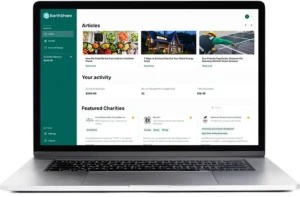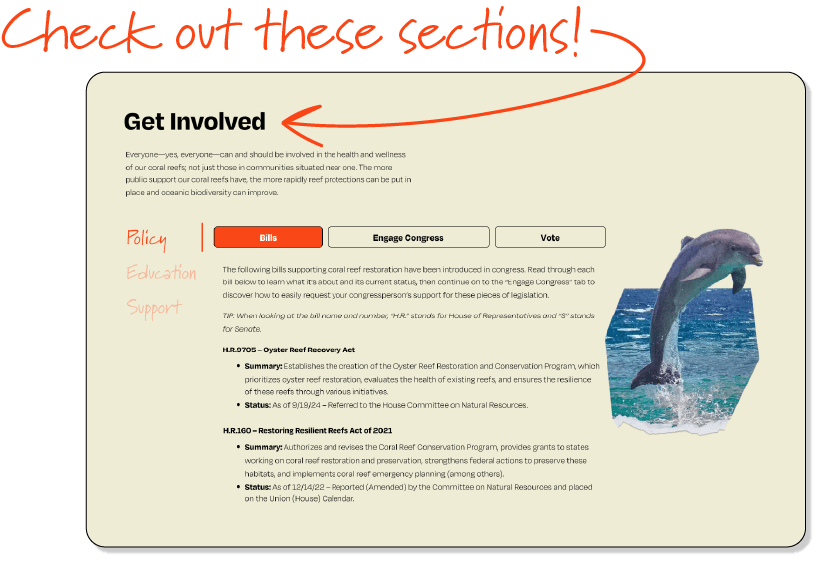SOLUTION
Renewable Energy
Advancing 30×30 goals by expanding the adoption of renewable energy
For more on renewable energy, visit
Environmental & Energy Study Institute (EESI)
What is renewable energy?
By now, you’re likely no stranger to the concept of renewable energy, but what do we mean by renewable energy adoption? We’re referring to the widespread transition from reliance on common fossil energy sources—natural gas, oil, coal, and other fossil fuels we take from the earth—to sources that are not depleted as they’re consumed. Some of the most popular examples of renewable energy include:
Nuclear and biomass energy are frequently discussed alongside these other clean energy solutions (energy sources that don’t result in greenhouse gases or pollution), but are considered only intermediate solutions given that neither is entirely clean nor renewable.
Biomass energy from human or animal waste is also a nonrenewable source, and while it’s possible to create biofuels from things like algae (a resource that can be made renewable through dedicated farming practices and natural collection), both instances require the burning of some form of gas to produce energy. This, in turn, produces greenhouse gases, though at a significantly smaller concentration than fossil fuels.1“Fact Sheet | Climate, Environmental, and Health Impacts of Fossil Fuels (2021),” Environmental and Energy Study Institute ≫
While both nuclear and biomass energy are considered somewhat less harmful than fossil fuels due to emitting far fewer greenhouse gases, they still do produce some amount of carbon dioxide in addition to posing unique health risks to nearby communities; biomass produces airborne particulates, and nuclear creates toxic waste.
These energy sources will likely play a critical role in the transition away from fossil fuels, which is great, but it’s important to note that they are not 100% clean or renewable energy sources and should not be relied on as long-term energy solutions.
Indigenous Nations and Renewable Energy
Equitable, sustainable change must include Indigenous communities, yet they have historically been excluded from clean energy projects. Many Native American tribes are eager to develop renewable energy and achieve energy sovereignty but struggle to access federal subsidies.2“Native Americans are building their own solar farms,” BBC ≫
Tribal lands have the potential to generate 6.5% of all U.S. utility-scale renewable energy, yet many Native Americans still face daily energy insecurity. While harnessing renewable energy on tribal lands could support both tribal energy sovereignty and national clean energy goals, projects must respect Indigenous rights. Indigenous lands have long been exploited for fossil fuel extraction without consent, harming both communities and biodiversity.3“Extraction Operations on Indigenous Peoples’ Land without Consent Cause Irreparable Harm, Speakers Stress, as Permanent Forum Begins Session,” United Nations ≫; “Renewable Energy Unlocks Energy Sovereignty for Tribal Nations, Changing Lives,” EESI ≫; “Renewable Energy Development on Tribal Lands,” U.S. Dept. of Energy ≫
Indigenous leadership is essential in decision-making, implementation, and management of energy projects on their lands. A strong example is a wind energy project in rural Alaska, where two Alaska Native Villages, Stebbins and Saint Michael, have relied on costly imported fuel. Thanks to Indigenous-owned utilities, wind energy will now supply 50% of their energy needs, saving over $11 million. Similar projects across the U.S. highlight the importance of Indigenous-led utility-scale renewable energy for a just and sustainable future.4“Tribal Energy Snapshot: Alaska Village Electric Cooperative and Stebbins Native Corporation,” U.S. Dept. of Energy ≫; “Powering Affordable Clean Energy in Rural Areas: Showcasing Three Rural Cooperatives,” EESI ≫; “Three Microgrid Projects in Rural Areas Showcase New DOE Program,” EESI ≫
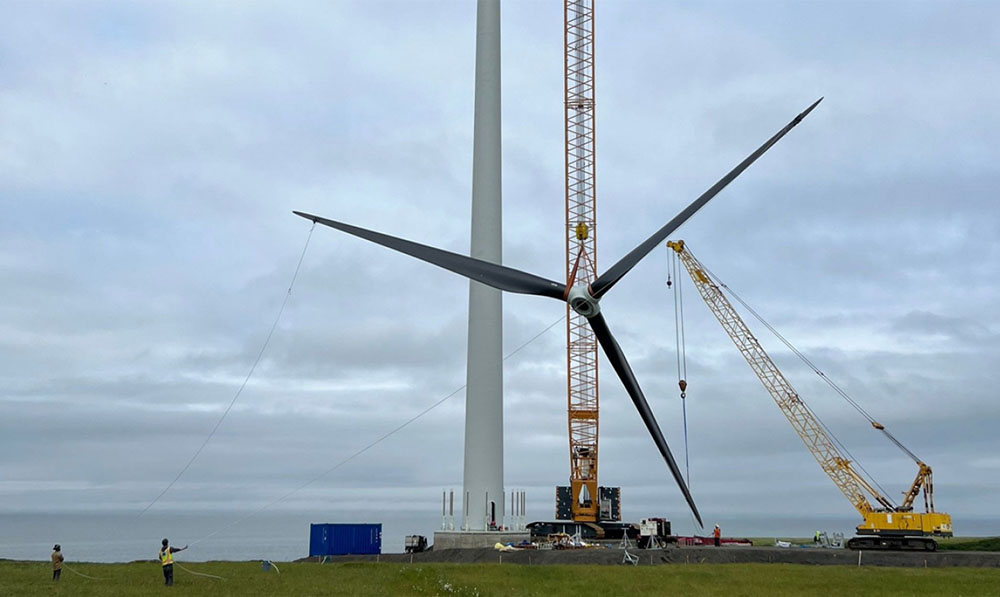
Wind turbine blades are installed in Stebbins, Alaska, where an Indigenous-led project reduces energy costs, spurs development, and curbs emissions. (IMAGE: Stebbins Native Corp./U.S. Dept. of Energy)
Current Challenges with Renewable Energy
If we’re going to significantly increase the amount of renewable energy projects across the United States and around the world, we first need to address some of the biggest concerns and obstacles to these initiatives. Click through each challenge to learn more about what it is and how it can be addressed.
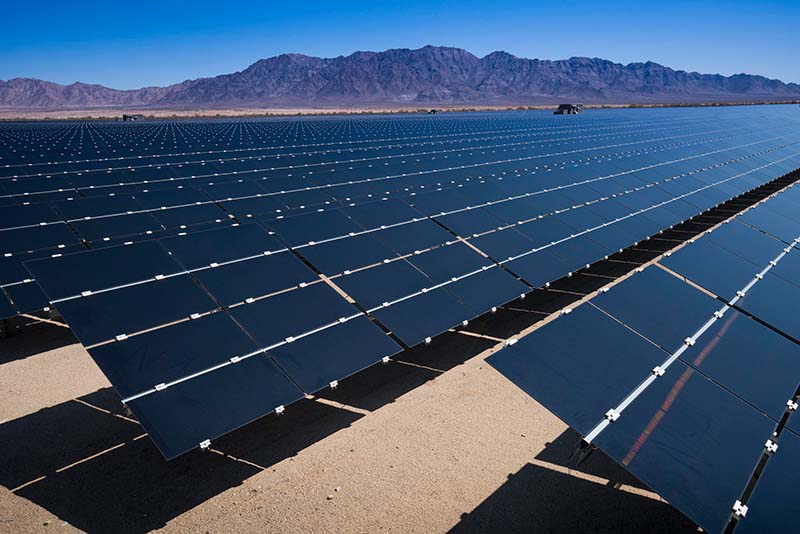
California’s Desert Renewable Energy Conservation Plan (DRECP) streamlines renewable energy development while conserving desert ecosystems. (IMAGE: Tom Brewster/U.S. Bureau of Land Management)
Renewable Energy in the United States… So Far
The United States has shown a lot of momentum in the adoption of renewable energy and clean energy policies in the past couple of years. Of all new electricity generation projects occurring in the United States, renewable energy sources—particularly solar—dominate the field. 2023 saw a 55% increase in solar installations over 2022. Five percent of the United States’ electricity can now be generated by solar alone. Likewise, wind power projects produce about 11% of U.S. electricity.5“US Clean Power Development Sees Record Progress, as Well as Stronger Headwinds,” World Resources Institute ≫
The United States has set a goal of achieving 100% clean energy by 2035 through an array of approaches, including biomass, nuclear, and geothermal during times of system need. So far, we’ve achieved 8.8% of total U.S. energy needs (and 23% of electricity needs) being met by renewable sources. And while these numbers are encouraging, clearly there’s still a long way to go before we reach carbon neutrality. The U.S. needs to ramp up our efforts dramatically if we want to achieve global climate goals before it’s too late.6“On the Path to 100% Clean Electricity,” U.S. Department of Energy ≫; “The 2024 Sustainable Energy in America Factbook,” BloombergNEF ≫
Renewable Energy and 30x30
How does where we get our energy relate to the 30×30 target and land, water, and biodiversity conservation? Good question.
Retrieving fossil fuels is an intensive process, and one that has many significant repercussions on our environment.7“Fossil Fuels,” EESI ≫ Drilling, mining, and fracking have all been linked to habitat loss, decreased air quality, and environmental contamination (including groundwater contamination) due to the toxic chemicals, gases, and waste used and produced during these processes.
Water, in particular, is an important part of fossil fuel retrieval with billions of barrels of wastewater being produced on an annual basis in Texas alone—a number that’s estimated to increase to more than 20 billion by 2030. A transition to renewable energy would decrease water usage for energy by 99%. Other negative environmental impacts of fossil fuel extraction, refining, and burning include toxic waste and significant carbon emissions.8“Texas’ oil and gas industry will produce “massive amount” of toxic wastewater with few reuse options, study finds,” Texas Tribune ≫;”Thirsty Fossil Fuels: Potential for Huge Water Savings by Switching to Renewables,” Food and Water Watch ≫
“At every stage of their lifecycle, fossil fuels directly contribute to biodiversity loss by causing pollution, planet-warming carbon emissions, and the destruction of critical habitats.”
Renewable Energy and Climate Change
The main cause of climate change? Carbon dioxide (CO₂) levels and other greenhouse gases in our atmosphere. The biggest contributors of greenhouse gases? Fossil fuels. Most fossil fuel emissions occur as the result of fuel combustion (a.k.a., the burning of oil/gas), however, a significant percentage can also be attributed to the energy required to extract raw materials from the Earth and transport and process them. Cutting fossil fuel emissions by transitioning to clean, renewable energy is the primary way to impact the rate and severity of climate change.10“Setting the Record Straight About Renewable Energy,” World Resources Institute ≫
“Renewables are becoming less expensive and more reliable than fossil fuels, and energy efficiency has proven itself the most reliable, abundant, and cost-effective form of energy security.”
That said, it’s also important we don’t increase the harm to our environment in our rush to implement renewable energy at scale. This means addressing multiple considerations, such as where and how we’re mining the materials needed to build renewables (a social and economic issue that disproportionately impacts Indigenous communities), where solar and wind farms are installed to have the least environmental impact, and what happens to solar panels and wind turbines once they’ve reached end-of-life. By developing solutions now, we can better mitigate environmental and social harms as we increase renewable energy adoption.12“Mining the Earth for Solar Panels?” BAI Group ≫
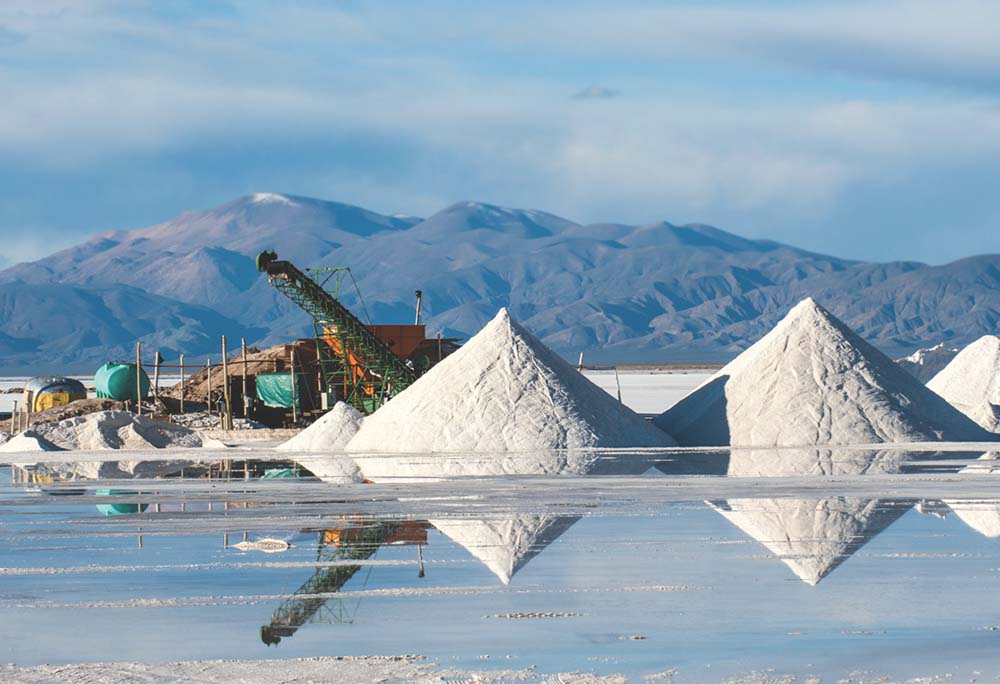
Working lithium mine in the Salinas Grandes salt desert of Jujuy province, Argentina (IMAGE: Earthworks/Flickr)
Renewable Energy: The Low Down
Learn about the who, where, and when of leveraging renewable energy for 30×30 goals.
- The Who
- The Where
- The When
Renewable energy is being adopted around the world, from Iceland that’s 66% powered by geothermal energy to Brazil where renewable energy makes up 83% of its electricity matrix. But who will be and should be part of this transition?13“Geothermal,” Government of Iceland ≫; “Brazil: Renewable Energy Infrastructure,” U.S. International Trade Commission ≫
Let’s start by looking at some of the groups, on a national scale, with the most influence and potential to initiate change financially, legislatively, and otherwise.
The industry worth calling out specifically due to their significant influence when it comes to energy is Big Oil and Gas. Countless studies and statistics have associated and proven the causation between fossil fuels and climate change, yet the fossil fuel industry insists it’s not to blame.14“Denial, Disinformation, and Doublespeak: Big Oil’s Evolving Efforts to Avoid Accountability for Climate Change,” U.S. House Committee on Oversight and Accountability Democrats, Senate Committee on the Budget ≫
Unless governments intervene and require fossil fuel corporations to take responsibility for the outcomes of their actions, nothing is likely to change in this regard. And while these companies may be investing in renewable energy projects, this is not currently happening at a scale that would lead to significant, immediate change. In fact, the past two years have seen a drop in renewable energy investment from Big Oil and Gas. Furthermore, these investments do not free them from the harms of their past actions or the ongoing impact fossil fuels have on our planet.15“Big Oil Pivots Away from Renewable Power on Low Returns,” BloombergNEF ≫
To have the most immediate and beneficial impact, where should we scale up renewable energy adoption? And where should we build renewable energy sites so they don’t negatively impact our already-suffering environment?16“our questions answered: Where should we develop renewable energy?” The Wilderness Society ≫
Transitioning to a clean grid and an energy system dominated by renewables gives us a chance to address critical energy insecurities throughout the United States and around the world, both in urban and rural settings. This is particularly important for Black, Indigenous, People of Color (BIPOC) communities in the United States, both on and off tribal lands, whose frequent lack of access to stable electricity is the direct result of systemic environmental injustices.17“2024 Sustainable Energy in America Factbook,” EESI ≫; “Energy, the Environment, and Justice,” Stanford University ≫
As for where we can and should build renewable energy plants and infrastructure, the Environmental Protection Agency estimates that up to 43 million acres of land in the United States have already been harmed by traditional fossil fuel extraction practices such as drilling and mining, so let’s start there.18“Your questions answered: Where should we develop renewable energy?” The Wilderness Society ≫ By using land that’s already been harmed and is not capable of being fully recovered—like former industrial sites, abandoned mines, and capped landfills—we minimize the risk to other lands, waters, and ecosystems and reduce our environmental footprint.
Likewise, federal lands and community spaces, existing public utilities, and universities are all great sites to begin or complete the transition to 100% clean energy. Check out other projects happening across the United States to implement renewable energy solutions.
Environmental and Energy Study Institute (EESI) | National
EESI is a 40-year-old environmental policy organization focused on providing resources for national policymakers and Congressional staff. Learn more >>>
RENEW Wisconsin | Wisconsin
RENEW Wisconsin is a nonprofit organization that has been accelerating the transition and equitable access to renewable energy in the state of Wisconsin since 1991. Learn more >>>
Southern Alliance for Clean Energy | Southeast US
The Southern Alliance for Clean Energy (SACE) is changing the way southereastern U.S. states produce and consume energy. Learn more >>>
As previously mentioned, examples of renewable energy projects are located all over the world today with more currently in development. According to a study conducted by Butler University, at our current rate, it’s likely that U.S. cities will only receive 10% of energy (or 35% to 65% in best case scenarios) from renewable sources in the next 20 or 30 years. On the surface, that sounds impressive… until you realize 2030 is less than five years away and our CO₂ emissions are higher than ever. So, it’s time to ramp up our efforts.19“Renewable Energy Goals Are Unattainable by 2050,” Butler University ≫; “Energy Transition Outlook: Renewables still not replacing fossil fuels in the global energy mix,” DNV ≫
But how long does one of these projects typically take from ideation to completion? And how long before the United States can fully rely on renewables to meet our energy needs?
It typically takes five or more years to develop a utility-scale solar power plant. Onshore wind plants at this same scale can take four to eight years to complete, while offshore wind farms take anywhere from seven to 11 years. Both geothermal and hydropower plants range from five to 15 years to complete. And that’s before any of this power goes on the grid.20“Everything you’d like to know about offshore wind farm construction,” Iberdrola ≫
There’s a lot of planning, permitting, and development involved in the structural building alone. And this doesn’t even factor in the time needed to update America’s very old, very outdated electrical grid.
A global transition to clean, renewable energy will take decades, so we need to get started ASAP. Luckily, there are already folks on the ground helping to move the needle in the right direction.
Get Involved
EVERYONE can help the transition to renewable energy, and strong public support is one of the fastest ways to set change in motion, especially in the face of significant obstacles created by rapidly changing federal policy.
Explore below to learn more!
- Policy
- Education
- Support
- Bills
- Engage Congress
- Vote
The following bills supporting open spaces have been introduced in congress. Read through each bill below to learn what it’s about and its current status, then continue on to the “Engage Congress” tab to discover how to easily request your congressperson’s support for these pieces of legislation. (When looking at the bill name and number, “H.R.” stands for House of Representatives and “S” stands for Senate.)
H.R.1483 – End Oil and Gas Tax Subsidies Act of 2023
- Summary: Limits or repeals fossil fuel oil and gas subsidies for oil companies and expands the definition of crude oil to include petroleum and petroleum-based products.
- Status: As of 3/9/23 – Referred to the House Committee on Ways and Means.
H.R.2520 – Renewable Energy Jobs Act
- Summary: Directs the Department of Labor to establish a pilot program to award grants for career training in renewable energy and energy efficiency.
- Status: As of 4/6/23 – Referred to the House Committee on Education and the Workforce.
- Similar Bills: H.R.6888 – Clean Energy Workforce Act
S.5352 – American Renewable Energy Act of 2024
- Summary: Establishes a Federal renewable electricity standard for retail electricity suppliers to increase the percentage of renewable-derived electricity to 70% by 2034.
- Status: As of 11/20/24 – Read twice and referred to the Committee on Energy and Natural Resources.
H.R.5191 – Renewable Energy for U.S. Territories Act
- Summary: Directs the Department of Agriculture (USDA) to establish a grant program for renewable energy systems, energy efficiency activities, energy storage, smart grids, or microgrids in U.S. territories.
- Status: As of 9/25/23 – Referred to the Subcommittee on Commodity Markets, Digital Assets, and Rural Development.
H.R.2703 – Green Energy for Federal Buildings Act
- Summary: Requires the federal government to increase the amount of renewable energy it consumes to 35% of its total electricity share by 2030, 75% by 2040, and 100% by 2050.
- Status: As of 4/19/23 – Referred to the House Committee on Oversight and Accountability.
Not sure who represents you in congress? Follow these quick steps to find your congressional representatives and how to contact them:
- Click here and input your home address, then click the search icon.
- Under the name of the representative you want to reach, look for the section titled “Contact.”
- To make a phone call, copy the phone number provided.
- To send an email (or other form of outreach), select the blue hyperlinked word “contact.”
- This will take you to a page with different methods for reaching your representative.
To make the process as simple as possible, we’ve provided you with email and phone call templates. Simply fill in the blanks with your information and then reach out to your representatives!
Your vote means something. It’s your chance to voice your support for the people and policies you think will make a positive difference in your community and across the country.
Register to Vote
Not yet registered to vote? Get started:
It’s super easy! All you have to do is:
- Select the state or territory you live in
- Start your online voter registration
When registering, make sure you have a valid form of identification. This could be your Driver’s License, State ID, and/or Social Security Number.
Find Your Voting Location
Are you a new voter? Have you moved recently? Or maybe you just want to double check you know where you’re going? Find your voting location:
Remind Others to Vote
- Text election reminders to friends and family
- Snap that “I Voted” selfie and share it with the world (this simple act has been shown to increase voter turnout by 4.1%)
- Help others create a voting plan
- Sign up for programs like When We All Vote to help educate others on the importance of voting, important deadlines, and more

- The Issue
- Advocate
- Keep Learning
There’s a lot of misinformation surrounding renewable energy solutions, and that’s because Big Oil and Gas companies have invested a lot of money to muddy the waters. The more people confuse and/or distrust renewable energy technology, the better for Big Oil’s bottom line.
Education is the most effective way of combatting this misinformation. Decades of peer-reviewed science (meaning scientists around the world from different fields of study and workplaces have tested, re-tested, and confirmed these theories) show that fossil fuels are responsible for climate change. The more we educate the public on this truth and the renewable energy solutions that exist to help combat climate change, the faster we’ll be able to build the momentum needed to implement change in our energy sector.
Share This Page
Help educate your network of friends, family and followers when you share this page and post about it on social media!
Explore Further
Interested in learning even more about the importance of renewable energy? We’ve compiled a list of key resources to help you move forward on your learning path.
Experts
Meet the professionals fighting for renewable energy throughout the U.S.
Learning Hubs
Dive deeper into the topic with more educational tools.
- Renewable Energy Data | Our World in Data
- Renewable Energy Maps & Tools | Federal Energy Management Program
- Renewable Energy Integration | NREL
- Climate, Energy & Environment | Pew Research Center
Other Resources
- Clean Energy News | Inside Climate News

- Nonprofit Limitations
- Donate
- Volunteer
Ask any nonprofit in America (and around the world) what their greatest two challenges are, and they are very likely to say the same things: funding and capacity.
Nonprofits striving to implement and advance renewable energy adoption throughout the U.S. and around the globe are no stranger to this. That’s why your support—be it financial or through volunteer work—makes an enormous difference. By supporting an organization with your time and/or money, you are helping to increase their impact, expand their reach, and make it easier for good to be done for our planet.
Donate to Nonprofits
Meet the vetted EarthShare Nonprofit Partners making a difference for renewable energy, and donate to their cause!
- Environmental and Energy Study Institute | Providing science-based educational resources to policymakers and the public on climate change, energy, and more
- Environmental Law Institute | Fostering innovative, just, and practical law and policy solutions to aid in the rapid adoption of cleaner energy
- Healthy Climate Wisconsin | Promoting climate-smart healthcare that prioritizes clean energy and reduces carbon emissions
- NW Energy Coalition | Advancing clean, equitable, and affordable energy policies through allyship and analytical expertise
- PennFuture | Leading the transition to a clean energy economy by empowering citizens to build sustainable communities
- RENEW Wisconsin | Developing policies and programs that expand renewable energy in Wisconsin
- Southern Alliance for Clean Energy | Supporting responsible and equitable energy choices to build healthy communities throughout the Southeast
- Union of Concerned Scientists | Using science to address global problems and forging a clean energy future
- Vermont Energy Education Program | Building a deep understanding of energy and climate through education
Want more ways to get involved? Check out events and volunteer opportunities happening online, across the country, and near you.
- Eco.Logic | Events | National
- Environmental Law Institute | Events | International
- NW Energy Coalition | Events | Regional (Northwestern U.S. & Canada)
- RENEW Wisconsin | Events | Wisconsin
- Southern Alliance for Clean Energy | Events | Regional (Southeastern U.S.)
- Union of Concerned Scientists | Volunteer | National
- Vermont Energy Education Program | Events | Vermont

- Policy
- Education
- Support
- Bills
- Engage Congress
- Vote
The following bills supporting open spaces have been introduced in congress. Read through each bill below to learn what it’s about and its current status, then continue on to the “Engage Congress” tab to discover how to easily request your congressperson’s support for these pieces of legislation. (When looking at the bill name and number, “H.R.” stands for House of Representatives and “S” stands for Senate.)
H.R.1483 – End Oil and Gas Tax Subsidies Act of 2023
- Summary: Limits or repeals fossil fuel oil and gas subsidies for oil companies and expands the definition of crude oil to include petroleum and petroleum-based products.
- Status: As of 3/9/23 – Referred to the House Committee on Ways and Means.
H.R.2520 – Renewable Energy Jobs Act
- Summary: Directs the Department of Labor to establish a pilot program to award grants for career training in renewable energy and energy efficiency.
- Status: As of 4/6/23 – Referred to the House Committee on Education and the Workforce.
- Similar Bills: H.R.6888 – Clean Energy Workforce Act
S.5352 – American Renewable Energy Act of 2024
- Summary: Establishes a Federal renewable electricity standard for retail electricity suppliers to increase the percentage of renewable-derived electricity to 70% by 2034.
- Status: As of 11/20/24 – Read twice and referred to the Committee on Energy and Natural Resources.
H.R.5191 – Renewable Energy for U.S. Territories Act
- Summary: Directs the Department of Agriculture (USDA) to establish a grant program for renewable energy systems, energy efficiency activities, energy storage, smart grids, or microgrids in U.S. territories.
- Status: As of 9/25/23 – Referred to the Subcommittee on Commodity Markets, Digital Assets, and Rural Development.
H.R.2703 – Green Energy for Federal Buildings Act
- Summary: Requires the federal government to increase the amount of renewable energy it consumes to 35% of its total electricity share by 2030, 75% by 2040, and 100% by 2050.
- Status: As of 4/19/23 – Referred to the House Committee on Oversight and Accountability.
Not sure who represents you in congress? Follow these quick steps to find your congressional representatives and how to contact them:
- Click here and input your home address, then click the search icon.
- Under the name of the representative you want to reach, look for the section titled “Contact.”
- To make a phone call, copy the phone number provided.
- To send an email (or other form of outreach), select the blue hyperlinked word “contact.”
- This will take you to a page with different methods for reaching your representative.
To make the process as simple as possible, we’ve provided you with email and phone call templates. Simply fill in the blanks with your information and then reach out to your representatives!
Your vote means something. It’s your chance to voice your support for the people and policies you think will make a positive difference in your community and across the country.
Register to Vote
Not yet registered to vote? Get started:
It’s super easy! All you have to do is:
- Select the state or territory you live in
- Start your online voter registration
When registering, make sure you have a valid form of identification. This could be your Driver’s License, State ID, and/or Social Security Number.
Find Your Voting Location
Are you a new voter? Have you moved recently? Or maybe you just want to double check you know where you’re going? Find your voting location:
Remind Others to Vote
- Text election reminders to friends and family
- Snap that “I Voted” selfie and share it with the world (this simple act has been shown to increase voter turnout by 4.1%)
- Help others create a voting plan
- Sign up for programs like When We All Vote to help educate others on the importance of voting, important deadlines, and more

- The Issue
- Advocate
- Keep Learning
There’s a lot of misinformation surrounding renewable energy solutions, and that’s because Big Oil and Gas companies have invested a lot of money to muddy the waters. The more people confuse and/or distrust renewable energy technology, the better for Big Oil’s bottom line.
Education is the most effective way of combatting this misinformation. Decades of peer-reviewed science (meaning scientists around the world from different fields of study and workplaces have tested, re-tested, and confirmed these theories) show that fossil fuels are responsible for climate change. The more we educate the public on this truth and the renewable energy solutions that exist to help combat climate change, the faster we’ll be able to build the momentum needed to implement change in our energy sector.
Share This Page
Help educate your network of friends, family and followers when you share this page and post about it on social media!
Explore Further
Interested in learning even more about the importance of renewable energy? We’ve compiled a list of key resources to help you move forward on your learning path.
Experts
Meet the professionals fighting for renewable energy throughout the U.S.
Learning Hubs
Dive deeper into the topic with more educational tools.
- Renewable Energy Data | Our World in Data
- Renewable Energy Maps & Tools | Federal Energy Management Program
- Renewable Energy Integration | NREL
- Climate, Energy & Environment | Pew Research Center
Other Resources
- Clean Energy News | Inside Climate News

- Nonprofit Limitations
- Donate
- Volunteer
Ask any nonprofit in America (and around the world) what their greatest two challenges are, and they are very likely to say the same things: funding and capacity.
Nonprofits striving to implement and advance renewable energy adoption throughout the U.S. and around the globe are no stranger to this. That’s why your support—be it financial or through volunteer work—makes an enormous difference. By supporting an organization with your time and/or money, you are helping to increase their impact, expand their reach, and make it easier for good to be done for our planet.
Donate to Nonprofits
Meet the vetted EarthShare Nonprofit Partners making a difference for renewable energy, and donate to their cause!
- Environmental and Energy Study Institute | Providing science-based educational resources to policymakers and the public on climate change, energy, and more
- Environmental Law Institute | Fostering innovative, just, and practical law and policy solutions to aid in the rapid adoption of cleaner energy
- Healthy Climate Wisconsin | Promoting climate-smart healthcare that prioritizes clean energy and reduces carbon emissions
- NW Energy Coalition | Advancing clean, equitable, and affordable energy policies through allyship and analytical expertise
- PennFuture | Leading the transition to a clean energy economy by empowering citizens to build sustainable communities
- RENEW Wisconsin | Developing policies and programs that expand renewable energy in Wisconsin
- Southern Alliance for Clean Energy | Supporting responsible and equitable energy choices to build healthy communities throughout the Southeast
- Union of Concerned Scientists | Using science to address global problems and forging a clean energy future
- Vermont Energy Education Program | Building a deep understanding of energy and climate through education
Want more ways to get involved? Check out events and volunteer opportunities happening online, across the country, and near you.
- Eco.Logic | Events | National
- Environmental Law Institute | Events | International
- NW Energy Coalition | Events | Regional (Northwestern U.S. & Canada)
- RENEW Wisconsin | Events | Wisconsin
- Southern Alliance for Clean Energy | Events | Regional (Southeastern U.S.)
- Union of Concerned Scientists | Volunteer | National
- Vermont Energy Education Program | Events | Vermont

Where to Start
We’ve curated a list of nonprofits doing work with renewable energy in the United States and around the world. Learn more about the incredible work they’re doing and show your support.
Check out these orgs!
Environmental and Energy Study Institute* | Providing science-based educational resources to policymakers and the public on climate change, energy, and more
Environmental Law Institute | Fostering innovative, just, and practical law and policy solutions to aid the adoption of cleaner energy
Healthy Climate Wisconsin | Promoting climate-smart healthcare that prioritizes clean energy and reduces carbon emissions
NW Energy Coalition | Advancing clean, equitable, and affordable energy policies through allyship and analytical expertise
PennFuture | Leading the transition to a clean energy economy by empowering citizens to build sustainable communities
RENEW Wisconsin | Developing policies and programs to expand renewable energy in Wisconsin
Southern Alliance for Clean Energy | Supporting responsible and equitable energy choices to build healthy communities throughout the Southeast
Union of Concerned Scientists | Using science to address global problems and forging a clean energy future
* EARTHSHARE 30×30 PARTNER
Created as part of the Mosaic 2023 Movement Infrastructure grant program
Share your thoughts on The 30×30 Project website
©2025 EarthShare. All rights reserved. EarthShare is a registered 501(c)(3) nonprofit.
